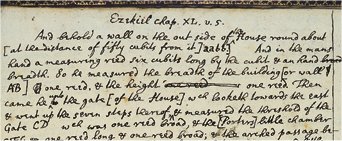 Cambridge University Library, Ms. Add. 3988, f. 102r
Cambridge University Library, Ms. Add. 3988, f. 102r
The history of worship played a substantial role in almost all of Newton's theological writings. The correct form of worship had been established by the patriarchs and was preserved for a time among both Jews and Gentiles. The history of its corruption was one of the major themes of Newton's interpretation of prophecy. Within that history, the idolatry of the Athanasians and their Catholic successors had a special place of infamy.
Newton began to investigate the history of worship in the 1670s. The study of the building and liturgy of the Temple of Jerusalem was particularly important for his exposition of the Book of Revelation, in which the Temple was the setting for the unveiling of prophecy. Newton's understanding of the Temple and its cult was transformed by his reading of Maimonides (see catalogue number 15) and other Jewish sources, probably in the early 1680s.
Newton made several attempts to reconstruct the appearance of the Temple. Of necessity, these were based largely on the account given in Ezekiel. They also drew heavily on earlier interpretations of this biblical text, especially those printed in the prolegomena to the London polyglot Bible, which Newton owned. Newton's task was made harder by the problem of determining the length of the ancient Hebrew cubit, the measure used in Ezekiel's description of the Temple.
The plan of the Temple of Solomon that is on display (figure 37) is taken from the manuscript used in the publication of Newton's Chronology of Ancient Kingdoms Amended (see catalogue number 63). It shows the Temple itself and the Court of Priests that surrounded it, both of which are enclosed by the larger Court of the People, around which a pavement runs on three sides.
Similar drawings by Newton (formerly in the library of Babson College, Wellesley, Massachusetts, Ms. 434) may be found in the Dibner Library at the Massachusetts Institute of Technology.
Presented to Cambridge University Library by the fifth Earl of Portsmouth. See A Catalogue of the Portsmouth Collection of Books and Papers written by or belonging to Sir Isaac Newton (Cambridge, 1888), p. 47
Newton's Chronology appeared in 1728, the year after his death, and was edited by John Conduitt (1688-1737). Conduitt had married Newton's niece in 1717 and acted as executor for the estate. He posted a bond to cover Newton's expenses at the Mint, where he succeeded Newton as Master.
Newton left no will when he died on 20 March 1727. In return for his expenses, Conduitt received Newton's manuscripts, although he had to cede any profits that might result from publication to be divided among the heirs. Newton's papers were appraised for probate on 18 April and subsequently moved to Conduitt's house in London.
Thomas Pellet, a fellow of the Royal Society, drew up an inventory of the manuscripts in May and then tried to determine what might be suitable for publication. He decided that five titles might be candidates for the press, of which three were successfully sold to booksellers and prepared for publication over the next few years. Conduitt had the manuscripts of these three books bound specially (see figure 38) but otherwise seemed largely unconcerned about the appearance of Newton's papers.
It was not surprising that the papers that made up the Chronology of Ancient Kingdoms Amended should have been among the unpublished works by Newton that found a buyer after his death. Newton himself had been preparing his chronology for the press when he died. His decision to undertake this work was prompted by the publication in Paris in 1725 of a pirated edition of one of his historical manuscripts.
After Newton's death, a text was established by Conduitt with the assistance of Pellet and Martin Folkes (see figure 39). Conduitt successfully obtained permission to dedicate the work to Queen Caroline, who had discussed it with Newton several years before in an interview that led indirectly to the Parisian piracy of part of its text.
The printed Chronology was not, however, a success. Despite the inclusion of a chapter discussing the Temple of Solomon, most of the work was based around an attempt to redate the history of the Greek, Egyptian, Assyrian, Babylonian and Persian empires. Newton ingeniously compared differing historical records and deployed astronomical as well as calendrical evidence to draw up a new chronology for the ancient world. Unfortunately, the material that Newton had been preparing to publish was deliberately shorn of most of its context in the history of ancient religion.

back to the top
|

